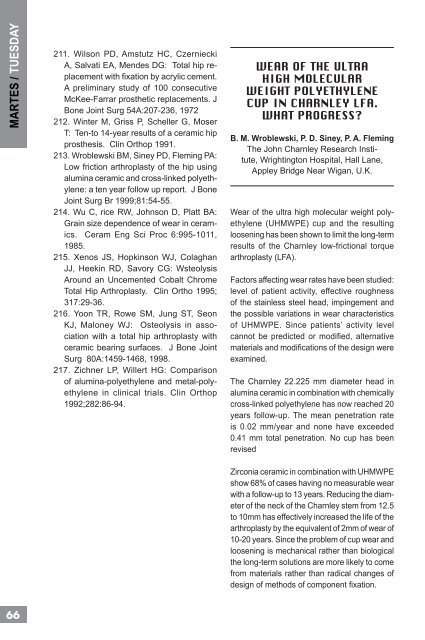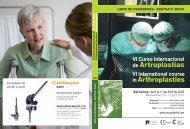cadera / hip - Active Congress.......
cadera / hip - Active Congress.......
cadera / hip - Active Congress.......
Create successful ePaper yourself
Turn your PDF publications into a flip-book with our unique Google optimized e-Paper software.
MARTES / TUESDAY<br />
66<br />
211. Wilson PD, Amstutz HC, Czerniecki<br />
A, Salvati EA, Mendes DG: Total <strong>hip</strong> replacement<br />
with fi xation by acrylic cement.<br />
A preliminary study of 100 consecutive<br />
McKee-Farrar prosthetic replacements. J<br />
Bone Joint Surg 54A:207-236, 1972<br />
212. Winter M, Griss P, Scheller G, Moser<br />
T: Ten-to 14-year results of a ceramic <strong>hip</strong><br />
prosthesis. Clin Orthop 1991.<br />
213. Wroblewski BM, Siney PD, Fleming PA:<br />
Low friction arthroplasty of the <strong>hip</strong> using<br />
alumina ceramic and cross-linked polyethylene:<br />
a ten year follow up report. J Bone<br />
Joint Surg Br 1999;81:54-55.<br />
214. Wu C, rice RW, Johnson D, Platt BA:<br />
Grain size dependence of wear in ceramics.<br />
Ceram Eng Sci Proc 6:995-1011,<br />
1985.<br />
215. Xenos JS, Hopkinson WJ, Colaghan<br />
JJ, Heekin RD, Savory CG: Wsteolysis<br />
Around an Uncemented Cobalt Chrome<br />
Total Hip Arthroplasty. Clin Ortho 1995;<br />
317:29-36.<br />
216. Yoon TR, Rowe SM, Jung ST, Seon<br />
KJ, Maloney WJ: Osteolysis in association<br />
with a total <strong>hip</strong> arthroplasty with<br />
ceramic bearing surfaces. J Bone Joint<br />
Surg 80A:1459-1468, 1998.<br />
217. Zichner LP, Willert HG: Comparison<br />
of alumina-polyethylene and metal-polyethylene<br />
in clinical trials. Clin Orthop<br />
1992;282:86-94.<br />
WEAR OF THE ULTRA<br />
HIGH MOLECULAR<br />
WEIGHT POLYETHYLENE<br />
CUP IN CHARNLEY LFA.<br />
WHAT PROGRESS?<br />
B. M. Wroblewski, P. D. Siney, P. A. Fleming<br />
The John Charnley Research Institute,<br />
Wrightington Hospital, Hall Lane,<br />
Appley Bridge Near Wigan, U.K.<br />
Wear of the ultra high molecular weight polyethylene<br />
(UHMWPE) cup and the resulting<br />
loosening has been shown to limit the long-term<br />
results of the Charnley low-frictional torque<br />
arthroplasty (LFA).<br />
Factors affecting wear rates have been studied:<br />
level of patient activity, effective roughness<br />
of the stainless steel head, impingement and<br />
the possible variations in wear characteristics<br />
of UHMWPE. Since patients’ activity level<br />
cannot be predicted or modifi ed, alternative<br />
materials and modifi cations of the design were<br />
examined.<br />
The Charnley 22.225 mm diameter head in<br />
alumina ceramic in combination with chemically<br />
cross-linked polyethylene has now reached 20<br />
years follow-up. The mean penetration rate<br />
is 0.02 mm/year and none have exceeded<br />
0.41 mm total penetration. No cup has been<br />
revised<br />
Zirconia ceramic in combination with UHMWPE<br />
show 68% of cases having no measurable wear<br />
with a follow-up to 13 years. Reducing the diameter<br />
of the neck of the Charnley stem from 12.5<br />
to 10mm has effectively increased the life of the<br />
arthroplasty by the equivalent of 2mm of wear of<br />
10-20 years. Since the problem of cup wear and<br />
loosening is mechanical rather than biological<br />
the long-term solutions are more likely to come<br />
from materials rather than radical changes of<br />
design of methods of component fi xation.





